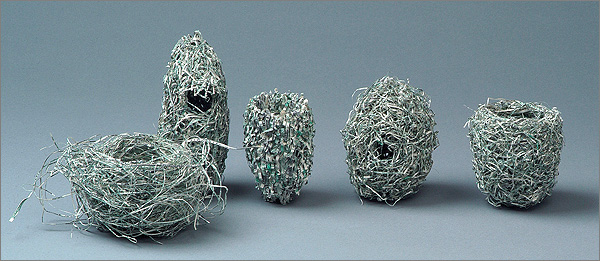

Mercantilism is the system for the major nations that traded goods (e.g. precious metals, gold etc ) during the 16th, 17th and 18th century. This was because national wealth/power was best seen by increasing exports and recieving precious materials, i.e. metals in return.
This has developed since the renaissance by the trade system becoming worldwide and much more common/frequent and much more goods are being exported and recieved rather than precious metals etc.
Fiona Hall's work, 'Tender' (2003-2005) relates to the renaissance concept of mercantilism with a number of reasons, firstly being that it represents other cultures of the west in which the australians traded with regularly during the renaissance time period, and with the sculpture consisting of one dollar bills represents the wealth gained within these trades. Secondly, it relates to this renaissance concept of mercantilism because she has grown more wealthier by using money as the sole material for her work, this relates because the in the renaissance era they mainly needed money to become wealthy, but here, she doesnt use it for trading, instead she using it to make art but in return, recieving the same outcome. They sculptures are shaped like the native birds nests of Australian wildlife, this represents the travel/amount of travel that was taken place within trading goods. The money used to make these also symbolise the good/wealth that was accumulated within the renaissance trading period.
The work 'Leaf Litter' (1993-2003) relates to the renaissance concept of mercantilism because the direction of the piece above the notes represents the trading business moving forward and progressing, This relates because the renaissance concept of mercantilism was constantly progressing and furthering their wealth and power.
http://en.wikipedia.org/wiki/Mercantilism
Firstly I looked at the piece "leaf litter" by Fiona Hall, I agree with kelly how it relates to mercantilism, however, I also think it is important to mention that the combination of leaves and bank notes relates to the concept because plants at the time were a raw source of income and this is shown by how the leaves are constructed out of currency. The leaves also resemble a native plant that have become endangered due to over harvesting because of the economic pressure. Hall I believe has made a creative piece of art work that evidently relates to the concept of mercantilism.
ReplyDeleteSecondly i looked the piece "tender". I believe this art work relates to the concept of mercantilism because the bird nests are constructed by woven together 1 dollar american bills. Money and wealth was very important during the renaissance because it kept a community alive. Fiona Hall's work relates to idea this because the american dollar is the most wanted curreyncie in the 3rd world countries and people who are desperate for it scavenge like birds to create there nests. This applies to many countries so this is why there are different nests, for different habitats.
I strongly agree with what you have written. Fiona Hall's work strongly relates to the Renaissance because of the wealth and power used in Hall's work. Hall's work definitely represents other cultures of the west because the sculpture consisting of one dollar bills represents the wealth gained within these trades that were happening in the west. Because the American currency is the most wanted currency for the Third World countries this relates to Hall's work 'Tender' as the people in the Third World countries are scavengers and are desperate for the American currency. I also agree with what you have said about mercantilism and how it has developed since the Renaissance by the trade system becoming worldwide, which is a very big development.
ReplyDeleteThe information Kelly has written about Fiona Hall's work is descriptive and informative, on this basis I agree with the information he has given. Significant points in this post define the relationship between Fiona Halls work and Mercantilism. kelly's ideas of the art peices representing the bird nests and travel help me to understand the background behind the artwork as well creating a deeper understanding of the artists point of view. Other good suggestions kelly made were money symbolising good wealth that accumulated in the renaissance period, this was an another idea that I did not really think of when researching this artist. Overall I believe this post has some interesting ideas that highlight the deeper understanding of money being associated with art.
ReplyDeleteFiona Hall's work defines a great relationship with Mercantilism. Which explores the money issues in society and how it relates to her own life.
ReplyDeleteI think its very interesting the way that she had sulptured this piece of work to look like Austrilia birds nest representing the travel amounts which has taken place with trading goods. Im also impressed by the renaissance which was a way that people showed their wealth emphasing how the artist herself is of high status.
I agree with the way you have communicated your idea. I think money was a huge factor during the Renaissance as it defined wealthy people from the poor. It influenced the power people had upon others. Hall has communicated this thorough the use of currency and economic power. Hall has definitely defined the meaning of Mercantilism in her work. She has also included reference to nature, with the bird nests which relates to the trading during Renaissance.
ReplyDelete